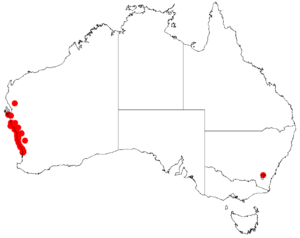White stemmed wattle facts for kids
Acacia xanthina, also known as the white stemmed wattle, is a cool plant that grows near the coast. It's usually a shrub (a bushy plant) or a small tree. This plant belongs to the Fabaceae family, which is also called the pea family. It's special because it's only found in Western Australia – meaning it's endemic there!
Quick facts for kids White stemmed wattle |
|
|---|---|
| Scientific classification | |
| Genus: |
Acacia
|
| Species: |
xanthina
|
 |
|
| Occurrence data from AVH | |
Meet the White Stemmed Wattle
The white stemmed wattle usually grows as a thick, bushy plant. It can be anywhere from 2 to 4 meters (about 6 to 13 feet) tall. Often, it spreads out and becomes wider than it is tall!
Its main stems and smaller branches often have a white, powdery coating. The branches themselves are white or greenish-white and can be quite twisty.
Like many other Acacia plants, it doesn't have regular leaves. Instead, it has something called phyllodes. These look like leaves but are actually flattened stems. The phyllodes of the white stemmed wattle are a pretty bluish-green color. They are usually 6 to 11 centimeters (about 2 to 4 inches) long and 1 to 2 centimeters (less than an inch) wide.
When it flowers, you'll see bright yellow, round flower heads. These usually grow in groups of six to nine, but sometimes you can find up to fifteen together! The white stemmed wattle blooms in late winter and spring, usually between August and October.
Where Did It Get Its Name?
The Acacia xanthina was first found by a botanist named James Drummond in 1839. Later, in 1842, another botanist named George Bentham officially described and named it.
The second part of its name, xanthina, comes from the Greek word xanthos. This word means yellow, which is a perfect description for its bright yellow flowers!
Where Does It Live?
This special wattle plant only grows along the west coast of Western Australia. You can find it in areas where the coast meets limestone rocks, often right next to sand dunes.
It lives in sandy soils. It's part of different plant groups like scrub, thickets (dense bushes), mallee (small, multi-stemmed trees), or low forest areas. You can find it from Fremantle in the south all the way up to Shark Bay in the north.

